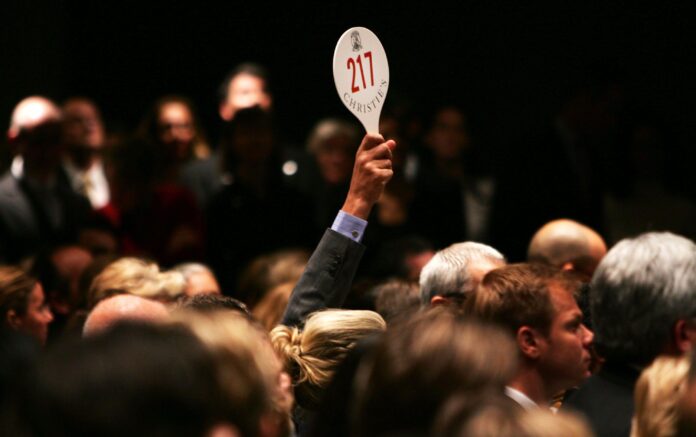The market for third-party guarantees—which offer auction houses and sellers a useful tool to hedge their bets—is showing no signs of slowing, reaching a likely record of $3.4bn in 2022. But a darker, lesser known market has been discovered by The Art Newspaper whereby third-party backers are selling off fractions of their guarantees to anonymous partners, sharing the risks as well as any upside.
Some of the biggest names in the game include the Nahmad family of art traders, the mega dealer Larry Gagosian and the billionaire collector José Mugrabi, all of whom are known to routinely offer third-party guarantees, or irrevocable bids, on works in exchange for a negotiated financial fee from the auction house. While Gagosian and Mugrabi are unlikely to need helping hands for their multi-million-dollar guarantees, the pair are understood to trade guarantees back and forth between them.

Left: mega dealer Larry Gagosian is said to be among the biggest players in the third-party guarantee game
Photo: Pascal Le Segretain/Getty Images
So why is this secondary market for guarantees emerging now? As the international art market softens in the wake of global economic insecurity, the appeal of third-party guarantees for auction houses, which can relieve reluctance on the part of wary consignors, has grown ever more attractive. It can be a winning solution for the guarantor, too, who either buys a work for an “insured” price if it fails to sell at auction, or gets a decent share of the profits if it sells above the guaranteed price.
However, while third-party guarantees assure a minimum price no matter how a work fares at live auction, they carry an increasing risk. According to the analysis firm ArtTactic, the estimated average return on guarantees has decreased from the peak in 2021 of 21.8%, to a seven-year low of 11.1% in 2022.
Of the developing secondary market for guarantees, one prominent New York attorney active in art market negotiations explains: “Third-party guarantors began to lay off some of their own risk to others; then, given the upside possibilities, a secondary market developed. People sought to get in on deals, and guarantors sold off some or all of their upside potential.”
A New York-based private dealer, who has orchestrated at least 20 or more of these deals, ran this writer through the steps of getting a third-party guarantee and what happens next.
“I go through the viewing and do some research and then decide whether to guarantee it or not. I approach one of the specialists who in turn approaches management for the possibility of a guarantee. When they come back to me—sometimes two days before the auction—and ask if I’m still interested, that’s when I call the people and ask if they want to go into it, at what percentage, etc. It’s usually in fours, sometimes threes, including myself, so I will own either 25% or 33% of the painting.
“Let’s say I guarantee it at 20% below the low estimate that’s set at $1.2m and I guarantee it for $800,000. If it sells for $1m, I get $40,000. If it doesn’t sell, it belongs to me.”
Asked if auction houses are aware that secondary deals are being brokered, the dealer says: “They might know unofficially because they see us hanging around together, but legally and paperwork-wise, I’m the only one and they prefer it that way.”
Against auction-house rules
This development and scenario flies in the face of, and seemingly violates, auction house rules and language found in third-party guarantor agreements. For instance, in a year-old example of a Christie’s agreement examined by The Art Newspaper between the auction house and the third-party guarantor, some of the fine print clearly states: “you shall not share any sums paid to you under this Agreement with any third party; and you have not and will not enter into any agreement with a third party concerning your interest in the Property and obligations pursuant to this Agreement.”
That language is pretty much boilerplate among the auction houses, according to several knowledgeable observers. A spokesman for Sotheby’s says the auction house is not able to comment “on the terms of our financial agreements with clients”.
Asked about that clause, the anonymous guarantor replies—somewhat in jest—“If you go letter by letter, no one would ever sign it.” He adds: “All I care about is the 20%, 25% or 30% or whatever the amount we agree on.”
Ironically, this relatively recent phenomenon has appeared and possibly flourished just a year after New York City unilaterally eliminated regulations on auctions and, with it, any official oversight of the art industry, including the requirement for the auction houses to announce when they have a financial stake in a piece being sold.
Still, evidence of these hedged third-party guarantee sell-offs is not widely acknowledged or recognised. “I have no examples of it,” says Jean-Paul Engelen, the president of Phillips. “But it’s totally possible. Is it that much different from dealers buying stuff together as partners? It’s a hedge against a hedge so I wouldn’t be surprised if it happened.”
The New York art lawyer Thomas Danziger of Danziger, Danziger & Muro says he has “heard in the past of people partnering up on these things” but adds: “I can’t tell you it’s a new thing; it sounds almost like a brokering of an irrevocable bid. It’s like the auction houses giving a guarantee to a consignor and then going off to unload risk to a third party which is the irrevocable bidder.”
Danziger says he has not observed first hand the selling-off of third-party guarantees, “but has it happened? Sure”.
No matter what form they take, third-party guarantees are evidently here to stay and have graduated from the perception of a decade or more ago that a marking of such in the catalogue was a knock on the picture.
As Engelen observes, “They are an important factor in today’s auction market, 100%.”

























